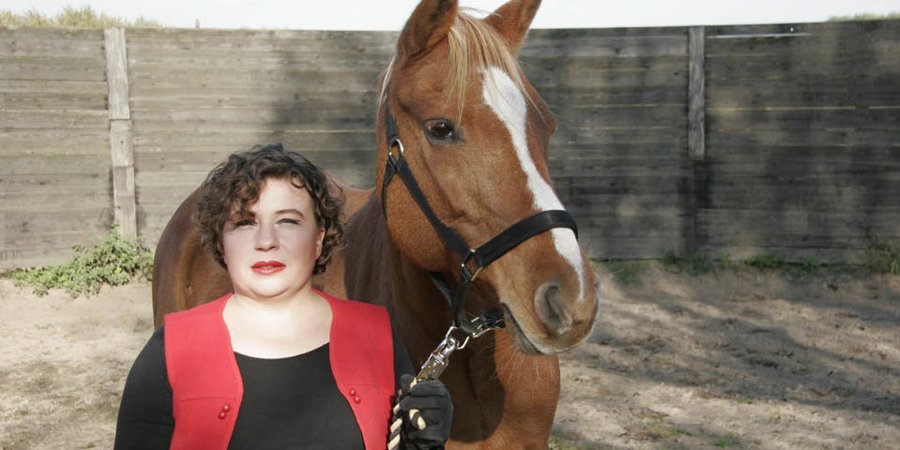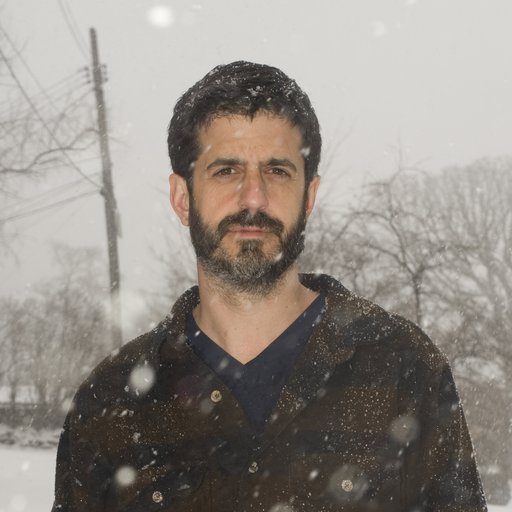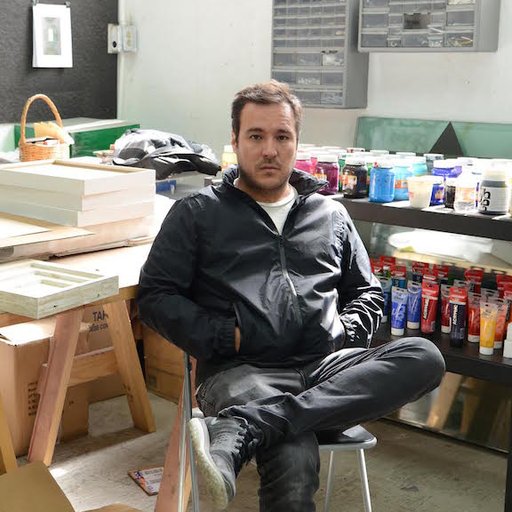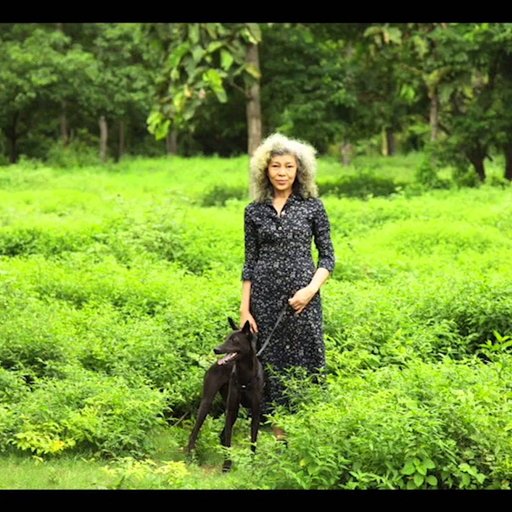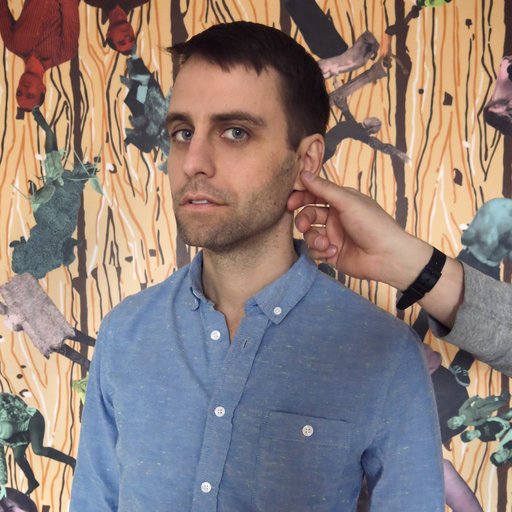Judith Hopf is the consummate “cool professor,” the one you wish you'd had in art school. Her humorously engaging films and sculptures titillate us with cement sheep, real horses, people in egg costumes, and other fun visuals—but behind the goofy gestures are some serious social issues and sly art-historical references.
On the faculty of Frankfurt's influential Städelschule, 46-year-old Berlin native has appeared in dOCUMENTA, the Berline Biennale, and other prestigious venues, and she's currently in the midst of a breakout moment, with prominent recent showings at SculptureCenter and the Liverpool Biennial; she has shows upcoming at Neue Galerie in Kassel, Kaufmann/Repetto in Milan, and Madrid's Museo de Arte Contemporaneo de Lima. We spoke to her about what it was like to begin her artistic career just as the Berlin Wall fell, the virtue of laughing at art, and her theory of productive stupidity.
People have described your films as “slapstick.” What’s the function of that kind of comedy in your work?
Often, I use forms in my films that relate to older cinema. For example, my last film Lily’s Laptop [2013] was almost quoting the early French film Le bateau de Leontine [Betty’s Boat] from 1911. I was wondering why these early films use so much slapstick, and I tried to bring back this energy by celebrating it. It’s also important to remember that none of this should be taken too seriously. It’s only art; it’s not a war or something like that.
I think it’s a little different in the U.S., but in Europe it was not so easy as a female artist to make people laugh. It was more about trying to survive at all.
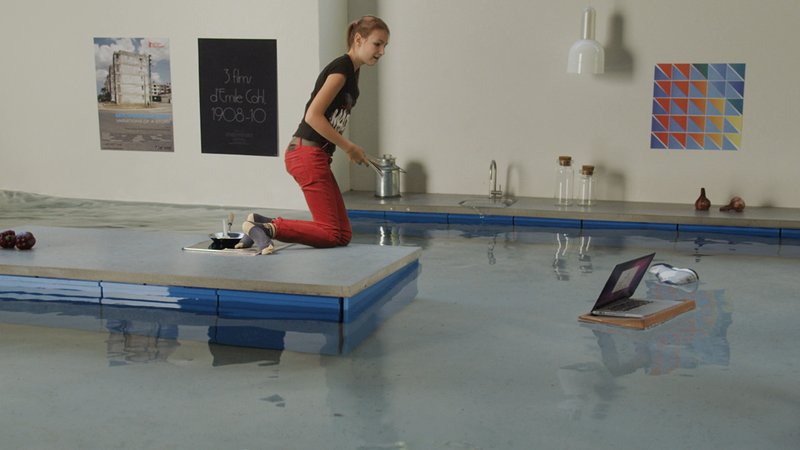 Still from Lily's Laptop, 2013. Video, 5:03 min (© Judith Hopf, courtesy Deborah Schamoni, Munich)
Still from Lily's Laptop, 2013. Video, 5:03 min (© Judith Hopf, courtesy Deborah Schamoni, Munich)
I see your works as oscillating between a critical, tongue-in-cheek stance and a more earnest and hopeful one, conveying the absurdity (or, to use your preferred term, “stupidity”) of contemporary life as well as a belief in the possibility of improvement. How do you navigate these opposing impulses?
I started my studies and practice as the Wall came down in Berlin—I’ve been working in Berlin for 25 years now. I guess this is the reason behind my interest in politics, because the circumstances of the time were such that you felt that things could really be changed. Coming up through the Western German education system as a child, I didn’t think that the situation could be changed. We’ll never know whether it changed for the best or the worst, but in the end there were real changes to our social and political realities. This was quite important for our generation of artists—you could see how fast things could be changed, because you could see the physical changes to the city as they took place.
The second factor was the discourse that came out of the ‘90s, where we learned so much that was left out of the school-sanctioned education in terms of post-colonial studies and issues around race, class, and gender. I thought, “If we’re trying to become more aware of inequalities through these radical social critiques, we should also at least acknowledge processes that are not academic, that are perhaps seen as ‘stupid.'" I think working with these other energies and not trying to view the situation from on high opens up possibilities.
So does your engagement with the “stupid” act as a rejoinder to the supposedly “wise” ideas of the ivory tower?
I try to accept the fact that it’s not only my wisest ideas that work on an aesthetic level, but that it could also be productive to let the stupid voices out. I’m not suggesting that stupidity is a positive energy—it’s more that you can’t avoid it. You don’t want to play the person that knows everything, because I don’t think we can really assume that position any more. Working with stupidity also allows for better experimentation, in that you don’t have the pressure that the piece has to work out.
 Still from Hospital Bone Dance, with Deborah Schamoni, 2006. Video, 7 min.
Still from Hospital Bone Dance, with Deborah Schamoni, 2006. Video, 7 min.
(© Judith Hopf, courtesy Deborah Schamoni)
You’ve worked as a teacher for most of your adult life. Do you see your works as instructional or imparting some kind of lesson?
I hope not! I’m quite a bad teacher, to be honest, but I do like to share the history of aesthetics. My decision to teach really came down to making a living. It was easier for someone in my position to go into the academic system because the market wasn’t as enthusiastic as it is now. I hope my works aren’t lessons. I hope it’s more that you find yourself in a structure where you have the experience of trying and failing to fit in.
Are you referring to your 2011 film Some End of Things: The Conception of Youth, in which a man in a giant egg costume tries and fails to fit through the doorways of a modern glass office building?
Yes. I think this impulse was also present in the early days of cinema—there were so many problems in the world, like the First World War and its effects. I think this collective laughing at these simple slapstick comedies served to relieve the pressure in some way, and I hope my own films can function similarly. The films are often shown in programs or events, and when I observe the people watching they’re not really laughing. However, if I’m talking about the films people will laugh, so that’s also interesting. Maybe they’re not really as funny as I thought, or maybe it’s just the convention that you’re not really allowed to laugh at art in these more formal circumstances.

(© Judith Hopf, courtesy Deborah Schamoni)
You’ve characterized the debate around good versus bad art as “boring.” What’s a more interesting criterion for evaluating artworks?
My generation was quite liberated by pop culture—it wasn’t easy in the German context to get over the Second World War, because it established hierarchies especially in the arts that are not helpful to the experimental visitor. I like experiment better than evaluation. I hope that the experimental can survive. It’s hard, because the economic pressure is quite tough for young artists.
Speaking of the experimental, you show in commercial and institutional spaces as well as alternative ones. How do you transition between these types of venues?
When the Wall came down in Berlin there were not too many opportunities to participate in the usual market system, so there was an effort to get people together to do something where we could at least communicate. I learned that you could get a lot out of these alternative modes of thought. On the other hand, it is also important to support these more established or commercial endeavors because our European system is not functioning as well as it was as a result of becoming more market-oriented. For example, if I do any shows in a museum I can’t be sure that I get a salary out of it.
 Installation view of Flock of Sheep, 2013. Concrete, armoring iron, styrofoam, wood, charcoal, dimensions variable
Installation view of Flock of Sheep, 2013. Concrete, armoring iron, styrofoam, wood, charcoal, dimensions variable
(© Judith Hopf, courtesy Deborah Schamoni)
Could you tell us a bit about your Artspace edition?
It's a print based on a wall drawing that I did. I really like the form of print—I do a lot of them, because they’re so nice to work with and you can do them by yourself. This one has a sort of graffiti quality, and there's also a reference to Helen Levitt’s photographs of children’s chalk drawings in New York.
The sheep motif in the print echoes one of your best-loved works, Flock of Sheep from 2013’s Liverpool Biennial (a group of cuboid concrete casts of corrugated cardboard boxes with cartoonish sheep faces and spindly steel legs). What do you make of the attention this work has received?
Don’t ask me—I have no idea! As with a lot of work, it comes from a quite precious moment, where you really have to solve a situation. In this case, I wanted to bring in these ideas of international trade and the fact that our things are often stored in these boxes. That was the experiment that I did: what if I rendered these moving boxes in a form in which they can’t be moved around anymore? The sheep came in because I thought, “We all store our belongings like this, so maybe it’s a group phenomenon.” I think there are a lot of points where people can relate to the sheep, because, while they're not the most intelligent beings, everyone loves them, but on the other hand they represent group pressure.
It seems like European art scenes in general have a more group- or community-oriented mentality.
I think so. There’s also a greater belief in the structure of collective capitalism, where you help out if the weak are falling out of the system. But the situation is as it is, and there's something funny about it, and maybe there are also some good opportunities in it. That could also be what the sheep are saying, as they are not moving, just staring back at you. I think that people also like that they're so simply done—it’s actually quite a spontaneous work, and you can repeat it wherever you go, though it changes from place to place because American storage boxes have different sizes than the ones in Europe, and the ones in Germany are even different from the ones in Switzerland. It’s quite interesting to me that something is working in these pieces at all. Maybe it’s the Saul Steinberg-esque face that’s working, or maybe its because the piece are not so expensive. I don’t know. Coming from the ‘90s and having this hardcore reflective thought going on all the time, I wonder why nobody is criticizing me for being so brutal. It’s not even trying to directly connect to any art history. That’s why I say there’s always a moment of embarrassment.
I think that feeling is pretty common among artists or people who put themselves out in the public sphere like this.
Do you think so? I do too. Maybe that’s the point where my work is working as well, because it’s about this position or artistic moment of trying to express something, whether political or aesthetic. Of course you hope that you can push your ideas to some new point, but it’s also embarrassing since we are only human beings. I hope all this combines into something—we’ll see how it lasts, how they look in five years.











